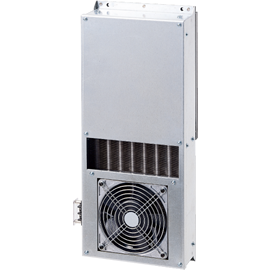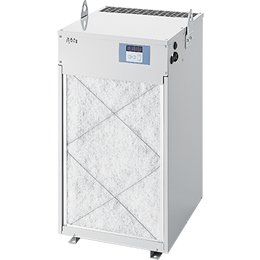Temperature and humidity control
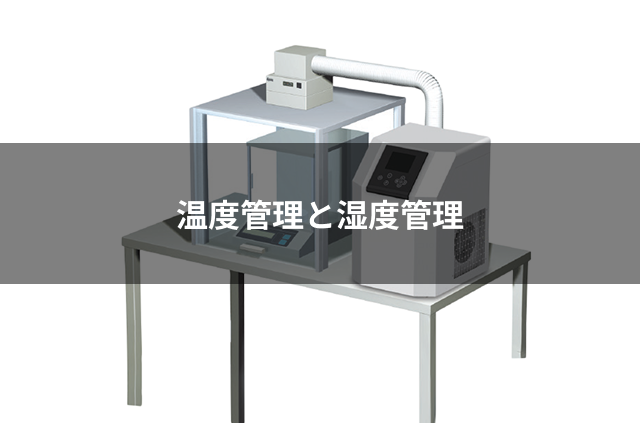
We will explain the necessity of temperature and humidity control in the manufacturing process, the necessary requirements for temperature and humidity control, the causes of not being able to maintain stable temperature and humidity, and basic countermeasures.
Table of Contents [display]
- What is temperature and humidity control?
- Why is temperature and humidity control necessary?
-
Reasons why stable temperature and humidity cannot be maintained and basic countermeasures
- There is a lot of heat coming in from the surrounding area
- High internal heat generation
- Poor airtightness
- There is a lot of traffic of people and vehicles.
- No air conditioning control system
- The rate of outside air intake is high due to overall, and adjustments are inappropriate in summer, winter, and the rainy season.
- Large fluctuations in the heat load of machines and equipment in the target space
- What are temperature control and humidity control?
- Selection of air conditioning method for temperature and humidity control
What is temperature and humidity control?
Generally, temperature control refers to a series of operational tasks that include mechanisms for maintaining temperature-sensitive products such as food, pharmaceuticals, and raw materials at an appropriate temperature. Therefore, the following requirements are considered necessary for temperature and humidity control:
- Measurement system ⇒ A system for periodically measuring temperature and humidity
- Control system ⇒ A mechanism to control and stabilize temperature and humidity
- Record storage system ⇒ A system for recording and storing temperature and humidity data and creating reports
- Operation management system ⇒ A system that allows continuous operation
For example, in the case of food, HACCP has been made mandatory by the revision of the Food Sanitation Act, requiring strict temperature control and temperature recording of food and raw materials.
Pharmaceuticals must be manufactured in compliance with the "Ministerial Ordinance on Manufacturing Control and Quality Control Standards for Pharmaceuticals and Quasi-Drugs (GMP Ministerial Ordinance)" due to the GDP guidelines established by the Ministry of Health, Labour and Welfare.
Apiste believes that air conditioning systems with the highest control stability and stability are needed to maintain and stabilize the right temperature and humidity in the target space, especially in the manufacturing process.
Why is temperature and humidity control necessary?
Food and medicine, which are essential commodities in our daily lives, are sensitive to temperature changes, and changes in temperature and humidity affect their quality and expiration dates. Temperature and humidity control is important from the standpoint of hygiene, food poisoning prevention, and food safety.
Furthermore, temperature and humidity control are of paramount importance for the manufacturing process of many parts and raw materials, including semiconductors and electronic components used in the automobiles, home appliances, and digital devices that support our daily lives, as these products have a significant impact on product performance, quality, and yield.
Furthermore, various products, foods, and raw materials are essential not only in the manufacturing process, but also during transportation and storage.
Related link: Case studies | Precision air conditioning and local air conditioning | Apiste Co., Ltd.
Reasons why stable temperature and humidity cannot be maintained and basic countermeasures
The reasons why temperature and humidity cannot be maintained stably vary greatly depending on the environment conditions of the target space.
Assuming you are indoors, here are some common causes.
There is a lot of heat coming in from the surrounding area
In places where the interior of a factory or warehouse is hot, where there is a heat source such as a boiler nearby, or where direct sunlight shines through a window, there is a lot of heat entering from the surrounding area, and the temperature and humidity within the space fluctuate greatly.
<Basic measures>
- Change the exterior walls and other parts to insulated materials or change them to a double-panel structure.
- Fill gaps in exterior walls with insulation material, stick it to the surface, or apply insulation paint to the surface.
- Install heat insulation boards/heat shields.
High internal heat generation
If the equipment or process within the target space generates a large amount of heat, the temperature and humidity within the space will fluctuate greatly.
<Basic measures>
- The equipment and process itself are insulated, and a separate heat exhaust system is installed.
- Install air conditioning and ventilation equipment.
Poor airtightness
If the target space, such as a storage room or panel, is not airtight, hot/cold air and humid/dry air will flow in through the gaps, causing fluctuations in the temperature and humidity within the target space.
<Basic measures>
- Gaps in spaces and housings are shielded or gasketed to increase airtightness.
There is a lot of traffic of people and vehicles.
When there is a lot of traffic in and out of a target space such as a factory or warehouse, or when there are a lot of transport vehicles coming in and out for delivery and shipping, outside air flows in through the entrances and exits, causing sudden changes in temperature and humidity.
<Basic measures>
- To reduce the opening area and shorten the opening time.
- Reduce the impact of direct outside air flowing in through double doors, etc.
No air conditioning control system
If the target space does not have an air conditioning or ventilation system, the temperature and humidity will fluctuate greatly.
<Basic measures>
- Install ventilation equipment.
- Install air conditioning equipment.
The rate of outside air intake is high due to overall, and adjustments are inappropriate in summer, winter, and the rainy season.
Factories and buildings that use overall need to bring in outside air, so the outside air intake rate can be high.
Furthermore, if proper adjustments are not made for each season or when it rains, overall system itself will be affected by fluctuations in the outside air, which will cause the indoor temperature and humidity to become unstable.
<Basic measures>
- Adjust and switch the dampers appropriately.
- Standards are established for managing and adjusting the rate of outside air intake in summer, winter, rainy weather, etc., and these are implemented daily.
Large fluctuations in the heat load of machines and equipment in the target space
Depending on target quantities, delivery dates, production progress, and other conditions, the operating rate of machines and equipment may vary significantly depending on the time of year and the time of day.
Such fluctuations in internal heat load can cause unstable temperature and humidity.
<Basic measures>
- We would like you to change the production plan to level out the operating rate as much as possible.
- Air conditioning and ventilation systems are adjusted as needed.
What are temperature control and humidity control?
Temperature control is the process of adjusting air in a certain state by heating or cooling it to a target temperature.
Humidity control is the process of adjusting air to a target humidity level by combining humidification/dehumidification with heating/cooling.
Temperature control is also called temperature control, and humidity control is also called humidity control.
Generally, a system that controls temperature and humidity is called air conditioning. Depending on the application and purpose, air conditioning can be classified into health air conditioning and industrial air conditioning.
| air conditioning | Healthy air conditioning: Air conditioning aimed at maintaining human comfort and health |
|---|---|
| Industrial air conditioning: Air conditioning for factories that control the quality and productivity of materials, and for raising non-human organisms. |
Temperature and humidity control in health air conditioning
Healthy air conditioning is a type of air conditioning that aims to improve people's comfort and maintain their health, and it promotes body temperature regulation by controlling the air in the spaces where people live.
Humidity affects the temperature perceived by humans. Low humidity makes people feel more comfortable in summer, while high humidity makes people feel more comfortable in winter.
The general comfortable temperature and humidity ranges are standardized by the American Society of Heating, Refrigerating and Air-Conditioning Engineers (ASHRAE) as ASHRAE standards.
| season | temperature | humidity | |
|---|---|---|---|
| Comfortable temperature and humidity guideline | summer | 25-28℃ | 50-60% |
| winter | 18-22℃ | 40-50% |
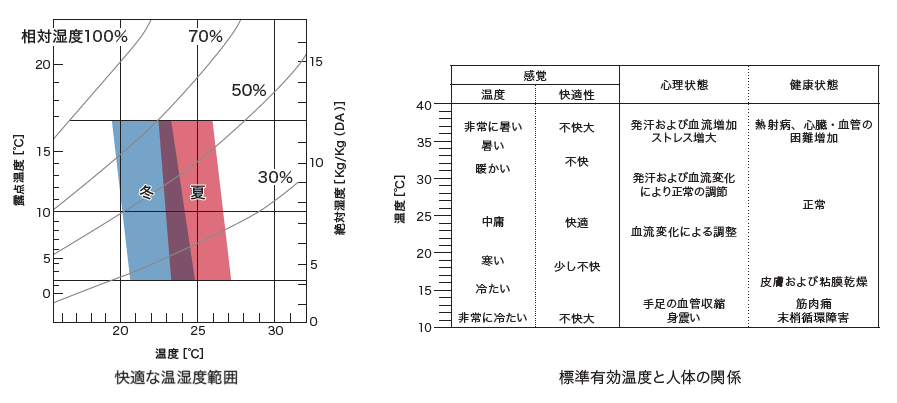
Temperature and humidity control in industrial air conditioning
Industrial air conditioning is air conditioning that aims to improve the quality of raw materials and parts and increase productivity in the production process.
Industrial air conditioning is particularly important among production facilities because it directly affects the quality, productivity, and yield of industrial products in the production process.
The required conditions such as temperature, humidity, and cleanliness vary depending on the product and production process.
| industry | process | Temperature conditions | humidity conditions |
|---|---|---|---|
| semiconductor | Photolithography | 22-24℃ ±0.2℃ or less | 45 to 50°C ±2 to 5% |
| Dry etching | 22-24℃ ±2℃ or less | 45 to 50°C ±5% or less | |
| sputtering | 22-24℃ ±2℃ or less | 45 to 50°C ±5% or less | |
| Pharmaceuticals | Powder storage | 24℃ ±3℃ or less | 30~50% |
| Tablet compression | 24℃ ±2℃ or less | 20~40% | |
| Macro analysis/serum | 24℃ ±2℃ or less | 50% | |
| Optical Lenses | polishing | 25℃ ±2℃ or less | 50℃ ±5% |
| printing | printing | 24 to 27°C ± 5°C or less | 50℃±2% |
| Cutting, drying, gluing, etc. | 21~27℃ | 45~50% | |
| food | Fresh bread | 24~26.5℃ | 40~50% |
| Raw material storage | 26.5~29.5℃ | 80~85% |
Apiste offers solutions to on-site temperature and humidity problems through the PAU series of precision air conditioner (TCU/ECU) and the ENC series of control panel cooling unit.
Selection of air conditioning method for temperature and humidity control
Air conditioning methods can be broadly divided into overall (central method) and individual air conditioning (distributed air conditioning).Individual air conditioning can also be divided into process air conditioning (precision air conditioning) and general air conditioning (air conditioner).
We compared overall, precision air conditioning, and general air conditioning for general industrial use in factories, etc. Precision air conditioning is by far the best choice when strict control of temperature and humidity is required in the manufacturing process.
| (guideline) | overall | precision air conditioning | General air conditioning |
|---|---|---|---|
| temperature stability | ▲±2~4℃ | ◎±0.1℃ | △±1~2℃ |
| Humidity stability | ▲±5~10% | ◎±0.5~1% | △±5% |
| Initial cost | ▲ | ○ | ◎ |
| Running costs | ▲ | ◎ | ◎ |
| maintenance | ▲ | ◎ | ○ |
| Individual Control | △ | ◎ | ○ |
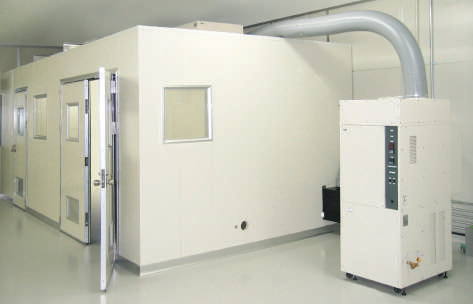
<Proposal for local precision air conditioning>
Apiste offers localized precision air conditioning for limited spaces in manufacturing processes for the following reasons:
- HFC alternative models are not subject to CFC regulations.
- It is easy to introduce and set up.
- Achieves high stability.
- Low initial/running costs.
- There are many energy-saving models available.
- Available for immediate delivery.

Reference sites
HACCP (HACCP) | Ministry of Health, Labour and Welfare website
https://www.mhlw.go.jp/stf/seisakunitsuite/bunya/kenkou_iryou/shokuhin/haccp/index.html
Food | Ministry of Health, Labour and Welfare website
https://www.mhlw.go.jp/stf/seisakunitsuite/bunya/kenkou_iryou/shokuhin/index.html



